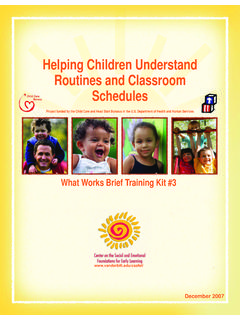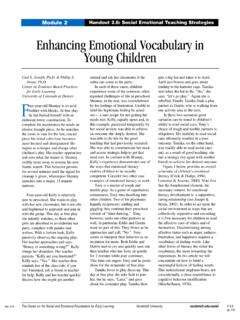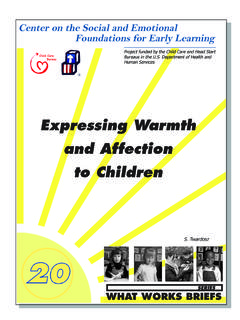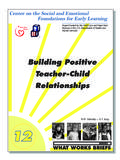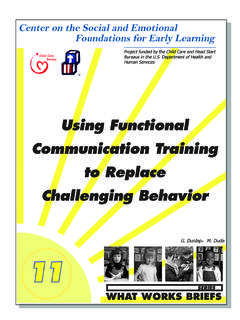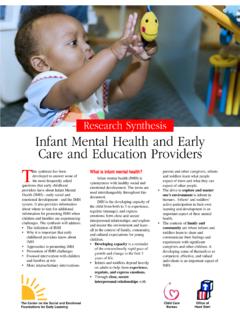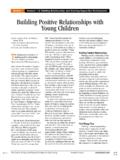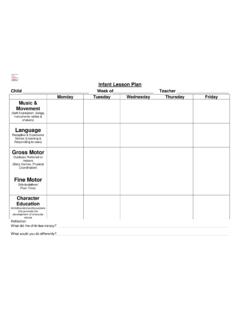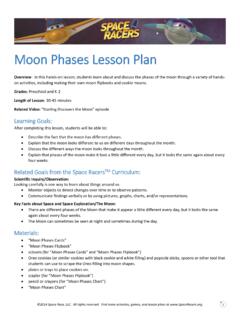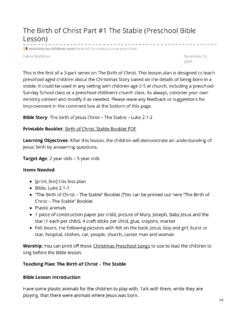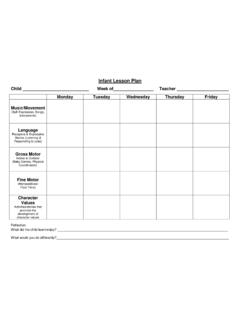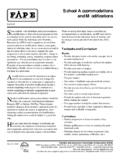Transcription of Module 2 Handout 2.7: Social Emotional Teaching Strategies ...
1 Handout : Social Emotional Teaching StrategiesModule 2 The Center on the Social and Emotional Foundations for Early Learning Vanderbilt H (p. 1/5)Rev. 2/10 Gail E. Joseph, & Phillip , on Evidence Based Practicesfor Early LearningUniversity of Colorado at DenverAs a result of his teachers carefulselection of toys, materials, andplay themes, 3 year old Eduardonow is able to benefit from his activeparticipation in a full range of freeplay activities. Yet, it is still the casethat without this level of planning andsubsequent, ongoing praise, Eduardowould spend most days playing alonewith a particular Tonka truck. On thisday the truck has been retired fromservice due to a broken and nowdangerous part. Visibly upset,Eduardo begins to whimper as histeacher explains the situation with thetruck and promises to get it replacedsoon.
2 She offers Eduardo other playideas and begins to play with othertrucks herself encouraging him to joinin. The disappointment is toooverwhelming, however, and Eduardojust sits passively, shaking his head,No. His teacher next prompts severalof his usual play partners to, AskEduardo to help with their building. When asked, Eduardo screams No, stomps over their building project andgets a predicable response from hispeers. The teacher intervenes at thispoint to protect Eduardo, his peersand the ongoing , a 4 year old in a localHead Start classroom is always thefirst to organize fun play when thewater table comes out each often talks with great anticipationand excitement (especially onThursday) about what she is going todo at the water table with her this Friday, the water table hasbeen borrowed by the class next doorand is not available.
3 When Mattierealizes that the water table is notavailable she seeks out her teacher forhelp. She does this with a clearexpression of frustration anddisappointment. Her teacher explainswhat happened and asks Mattie todescribe how she is feeling. She saysshe is frustrated. Her teacheracknowledges the legitimacy of herfeelings and asks her if she can thinkof what she and her classmates havepracticed when they feel some prompting, Mattie recallsthe plan takes three deep breaths,tell yourself to calm down, and thinkof some solutions. Mattie and theteacher generate some options at thispoint, including; a) playing with hernext favorite toy; b) asking her bestfriend what she wants to play; and c)pretending to use the water table. Shechooses b, and has a fun young children gain a betterunderstanding of emotions, theybecome more capable of emotionalregulation.
4 Controlling anger andimpulse is perhaps the most difficulttask of Emotional literacy. In real lifesituations that are upsetting,disappointing and frustrating it is atough undertaking to remain calm in the presence ofadverse situations is not about thesuppression of emotions, but thedynamic engagement of affective,cognitive and behavioral order to regulate emotions onemust bring into play the rapid andaccurate recognition of physiologicalarousal, the cognitive processrequired to think, for example, Ineed to calm down and, thebehavioral pretense of taking a deepbreath and reacting calmly. Childrenwho learn to cope with their emotionsconstructively not only have an easiertime with disappointments,aggravation, and hurt feelings that areso ubiquitous in the lives ofpreschoolers but they also have aneasier time relating to other childrenand adults at home, in school or childcare, and on the playground (NationalResearch Council and Institutes ofMedicine, 2000).
5 On the other hand, young childrenwho have failed to master the earlyregulatory tasks of learning tomanage interpersonal conflict andcontrol aggressive and disruptiveimpulses are more likely than theirself-regulated peers to display earlyconduct problems. Children withconduct problems and poor impulsecontrol are more likely to be peer-rejected and do more poorly in schoolthan children who are more capableat Emotional regulation and problemsolving (Strain, Kerr, Stagg &Lenkner, 1984). Before children caneffectively manage interpersonalconflict, they need to be able torecognize and regulate their ownemotional responses and stress can play a significant role inhelping children learn to control theiranger and impulses and to handledisappointment in appropriate waysby identifying and intervening withchildren who need extra help indeveloping these Teaching Strategies includemodeling remaining calm; cognitivebehavioral interventions; preparingchildren for disappointing situationsbefore they occur; recognizing andreinforcing when children remainHelping Young Children Control Angerand Handle Disappointmentcalm.
6 And involving parents and othercare remaining calmTeachers can model how tomanage anger and handledisappointment for young example, a teacher can share withher class how she felt angry whensomeone hit her car in the parking lot but then she decided that feelingmad wasn t helping her think of goodsolutions so she took three deepbreaths and thought about somethingrelaxing and then when she felt calmshe thought of some solutions forfixing her car. In addition to recallingincidents when one felt angry butremained in control teachers canalso model remaining calm asnaturally occurring disappointing,scary, frustrating and difficultsituations happen throughout the day( , a fire drill; being yelled at;having something break, etc.).Teach children how to controlanger and impulseWhile it may be true that childrenoften hear adults telling them to calm down, it is very unlikely thatthis simple direction will result in anychanges in children s affect orbehavior.
7 In some instances this kindof command may even escalate achild s angry response. Cognitivebehavioral intervention (CBI) Strategies can provide children withthe requisite skills to control angerand handle disappointment. CBIsoffer Strategies for teachingappropriate replacement skills toangry outbursts and aggression. CBIsengage a relationship betweeninternal cognitive events andbehavioral change through teachingstrategies that guide performance andreduce inappropriate CBI, teachers can provideyoung children with Strategies tomodify their thoughts and promoteself-regulation. With preschooler,many accidents occur in classrooms( , children bumping into oneanother; children knocking overothers constructions) and somechildren interpret these accidents aspurposeful, hostile acts. An essentialingredient of CBI is to help childrenreframe and modify their processes inorder to substitute more neutralinterpretations of others turtle technique is a CBIstrategy that has been usedsuccessfully with preschool andkindergarten age children (Greenberg,Kusche & Quamma, 1995;Webster-Stratton & Hammond, 1997).
8 The turtle technique was originallydeveloped to teach adults angermanagement skills then wassuccessfully adapted for school agechildren (Robin, Schneider &Dolnick, 1976; Schenider, 1974).Since then, the turtle technique hasbeen adapted and integrated intosocial skills programs for preschoolers(PATHS, Dinosaur School). The basicsteps of the turtle technique are:Recognizing that you feel angryThinking stop Going into your shell and takingthree deep breaths and thinkingcalming, coping thoughts, It was anaccident. I can calm down and thinkof good solutions. I am a goodproblem solver. Coming out of your shell whencalm and think of some solutions tothe the turtle technique toyoung children can happen at largeand small group times. A turtle puppetis helpful and keeps children engagedduring the lesson .
9 The teacher canbegin by introducing the turtle to theclass. After the children get a chanceto say hello and perhaps give a gentlepet, the teacher shares the turtle sspecial trick for calming down. Theturtle explains a time he got upset inpreschool (selecting an incidentfamiliar to the children is best). Hedemonstrates how he thinks to himself STOP, then goes in his shell andtakes three deep breaths. After hetakes three deep breaths, he thinks tohimself I can be calm and think ofsome solutions to solve my problem. When he is calm, he comes out of hisshell and is ready to problem solvepeacefully. The teacher can theninvite the children to practice turtle ssecret. Children can go in theirshells as a group and together takethree deep breaths. Then anindividual child can model the turtletechnique in front of the small group activities caninclude making paper plate turtleswith moveable heads and arms that go in their shell.
10 Children can thenrehearse the steps with the paper plateturtle. Preparing children to handledisappointmentTeachers can help children byrehearsing some Strategies to handledisappointment before a potentiallydisappointing incident occurs. Forexample, Elizabeth knows that somechildren will be disappointed becauseshe can only choose one helper tofeed the pet goldfish. Before sheannounces who the helper will be shesays to the class, Remember, I willonly be able to select one fish feedertoday, and that may make some of youfeel disappointed. What can you do ifyou feel disappointed? The childrentogether snap their finger and say, Ohwell, maybe next time. Elizabethsays, That is right you can say Maybe next time. After she selectsthe fish feeder, she reinforces thechildren who remained calm andhandled their , a teacher can prepare asingle child for a disappointingHandout : Social Emotional Teaching StrategiesModule 2 The Center on the Social and Emotional Foundations for Early Learning Vanderbilt H (p.)
